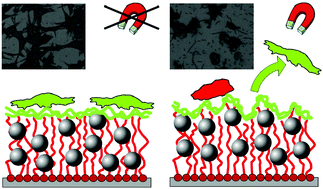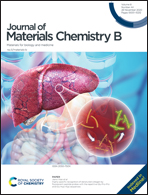Tailoring cellular microenvironments using scaffolds based on magnetically-responsive polymer brushes†
Abstract
A variety of polymeric scaffolds with the ability to control cell detachment has been created for cell culture using stimuli-responsive polymers. However, the widely studied and commonly used thermo-responsive polymeric substrates always affect the properties of the cultured cells due to the temperature stimulus. Here, we present a different stimuli-responsive approach based on poly(3-acrylamidopropyl)trimethylammonium chloride) (poly(APTAC)) brushes with homogeneously embedded superparamagnetic iron oxide nanoparticles (SPIONs). Neuroblastoma cell detachment was triggered by an external magnetic field, enabling a non-invasive process of controlled transfer into a new place without additional mechanical scratching and chemical/biochemical compound treatment. Hybrid scaffolds obtained in simultaneous surface-initiated atom transfer radical polymerization (SI-ATRP) were characterized by atomic force microscopy (AFM) working in the magnetic mode, secondary ion mass spectrometry (SIMS), and X-ray photoelectron spectroscopy (XPS) to confirm the magnetic properties and chemical structure. Moreover, neuroblastoma cells were cultured and characterized before and after exposure to a neodymium magnet. Controlled cell transfer triggered by a magnetic field is presented here as well.



 Please wait while we load your content...
Please wait while we load your content...